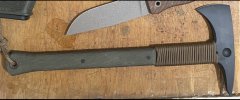There's the obvious Eswing hatchets and axes that others have mentioned. To be honest, if you twist/bend one, you'd have broken a wooden one a dozen times over. Although having to rehaft your wooden one a dozen times would likely have caused you to quit using them or learn how to use them correctly.
But since the tactical types, specifically the RMJ offerings were asked about, let's address that:
First, most of these were designed as breaching hawks and designed to chop steel, concrete, windshield glass, etc, and have very obtuse bevels, such as the RMJ Shrike. However, if you don't need those capabilities, then you can easily grind the bit to a convex grind, which we did to a friend of mine's Shrike who had become attached to it during his service and wanted to use it in civilian life as a camp tool. With the convex grind on it, it does tomahawk-class camp chores just fine.
The RMJ Berserker comes with a much more acute edge geometry out of the box, and if you convex it, rather than have an edge bevel, then it's a very good hatchet.
The Winkler hawks and camp hatchets I've seen vary. Their CQB combat axes are pretty thin in the bit and may stick badly in wood. Their camp and general-purpose axes work great, and they also taper thickness as you go down the handle to balance it more toward the head.
The main thing to consider is that they are not axes, compare them to tomahawks. After that, f you put a proper edge on them, they work just fine as tomahawks.



